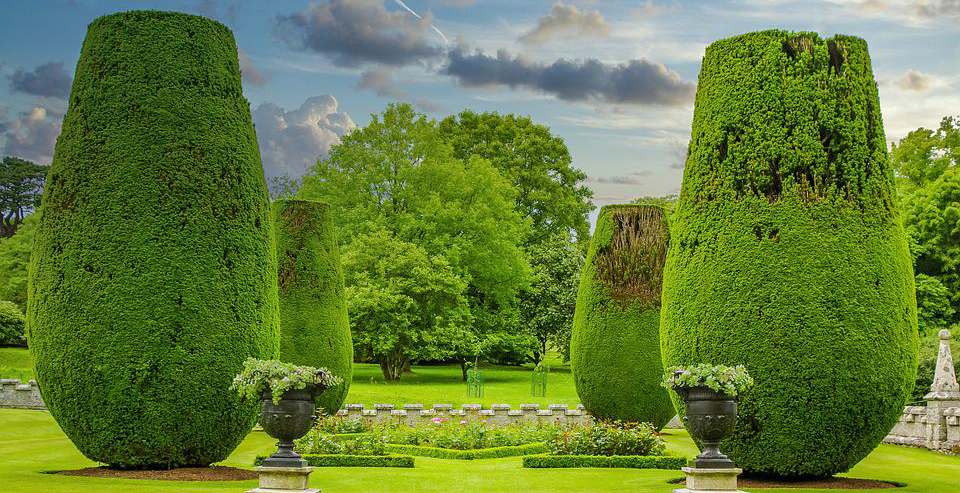Boxwood

|
Boxwood or Box often refers to Buxus, a genus of over fifty species in the family Buxaceae. It is also called Common Box or European Box (latin; Buxus sempervirens). These are slow growing evergreen shrubs or trees, that are generally lower than 10 metres, making them ideally suited and well know for their use for topiary.
There is evidence of boxwood growing in England as early as the 7000BC, but is died out, whilst by 000 the Egyptians were using it as hedging in gardens, and whilst the earliest record of the timber being used is a table in the tomb of King Midas in 00 BC which was discovered in 1951. The Romans re-introduced Boxwood to England in 100BC and Boxes are now considerd native to western and southern Europe, southwest, southern and eastern Asia, Africa, Madagascar and South America, great varieties found today in Cuba and China aswell as Madagascar.
The box hedge was not popular with the natural landscape movement of the 1700's and the renowned landscape designer Capability Brown removed much formal box hedging from gardens, and also in turn agricultural hedges might be replaced with sunken boundaries or Ha Ha's invented around the same time. The 1800's saw an influx or exotic plants alongside the trend for glasshouses and a return to the poularity of knot garden and parterres, which often featured clipped box hedging and edging with clipped cotton lavender. This continued into the 1900's with characters such a Lutyens and the increased appearance of topiary in the Chealsea flower show. Today boxwood species continues to be a staple hedging species and is not listed as being a species under threat.
The sapwood and heartwood for box are almost indistinguishable from one another, with the heart being considered durable whilst overall it is light cream yellow in colour which darkens with long sunlight exposure. As it is quite homogenous but generally small in size and therefore well-suited to carving and wood turning, for such things as chess pieces, musical instruments (flutes, recorders, woodwinds, etc.), rulers and handles.
[edit] Related articles on Designing Buildings
11 things you didn't know about wood.
Definition of tree for planning purposes.
Legally harvested and traded timber.
Predicting service life of timber structures.
Programme for the Endorsement of Forest Certification.
Recognising wood rot and insect damage in buildings.
The differences between hardwood and softwood.
Whole life carbon assessment of timber.
Wood and educational buildings.
Featured articles and news
One of the most impressive Victorian architects. Book review.
RTPI leader to become new CIOB Chief Executive Officer
Dr Victoria Hills MRTPI, FICE to take over after Caroline Gumble’s departure.
Social and affordable housing, a long term plan for delivery
The “Delivering a Decade of Renewal for Social and Affordable Housing” strategy sets out future path.
A change to adoptive architecture
Effects of global weather warming on architectural detailing, material choice and human interaction.
The proposed publicly owned and backed subsidiary of Homes England, to facilitate new homes.
How big is the problem and what can we do to mitigate the effects?
Overheating guidance and tools for building designers
A number of cool guides to help with the heat.
The UK's Modern Industrial Strategy: A 10 year plan
Previous consultation criticism, current key elements and general support with some persisting reservations.
Building Safety Regulator reforms
New roles, new staff and a new fast track service pave the way for a single construction regulator.
Architectural Technologist CPDs and Communications
CIAT CPD… and how you can do it!
Cooling centres and cool spaces
Managing extreme heat in cities by directing the public to places for heat stress relief and water sources.
Winter gardens: A brief history and warm variations
Extending the season with glass in different forms and terms.
Restoring Great Yarmouth's Winter Gardens
Transforming one of the least sustainable constructions imaginable.
Construction Skills Mission Board launch sector drive
Newly formed government and industry collaboration set strategy for recruiting an additional 100,000 construction workers a year.
New Architects Code comes into effect in September 2025
ARB Architects Code of Conduct and Practice available with ongoing consultation regarding guidance.
Welsh Skills Body (Medr) launches ambitious plan
The new skills body brings together funding and regulation of tertiary education and research for the devolved nation.
Paul Gandy FCIOB announced as next CIOB President
Former Tilbury Douglas CEO takes helm.






















